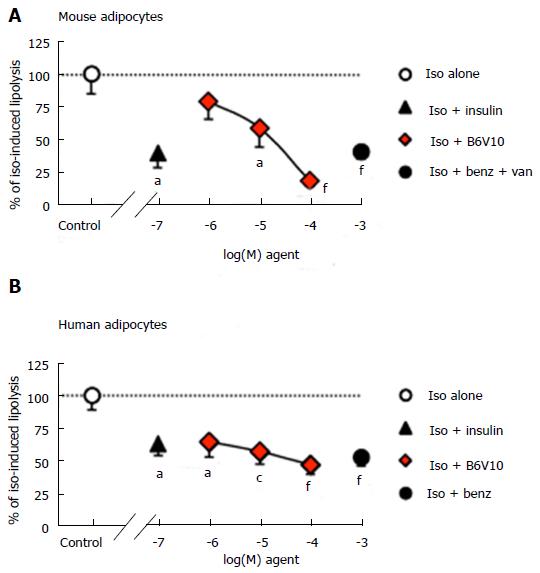Copyright
©The Author(s) 2017.
World J Diabetes. Apr 15, 2017; 8(4): 143-153
Published online Apr 15, 2017. doi: 10.4239/wjd.v8.i4.143
Published online Apr 15, 2017. doi: 10.4239/wjd.v8.i4.143
Figure 3 Comparison of the antilipolytic effects of B6V10 and insulin in mouse and human adipocytes.
Lipolysis was activated by 10 nmol/L isoprenaline and considered as a control set at 100% (iso alone, dotted line) while basal was set at 0% in: Mouse adipocytes (A) or human adipocytes (B). The observed lipolytic response to the β-adrenergic agonist was significantly reduced in the presence of insulin (100 nmol/L, closed triangle), benzylamine (1 mmol/L alone for humans, or combined with 0.1 mmol/L vanadate for mouse adipocytes, closed circle), or increasing doses of B6V10 (1-100 μmol/L, red diamonds), at: aP < 0.05, cP < 0.02, fP < 0.01. Mean ± SEM of 8 murine preparations (A) or 6-7 individual cases (B).
- Citation: Carpéné C, Garcia-Vicente S, Serrano M, Marti L, Belles C, Royo M, Galitzky J, Zorzano A, Testar X. Insulin-mimetic compound hexaquis (benzylammonium) decavanadate is antilipolytic in human fat cells. World J Diabetes 2017; 8(4): 143-153
- URL: https://www.wjgnet.com/1948-9358/full/v8/i4/143.htm
- DOI: https://dx.doi.org/10.4239/wjd.v8.i4.143









